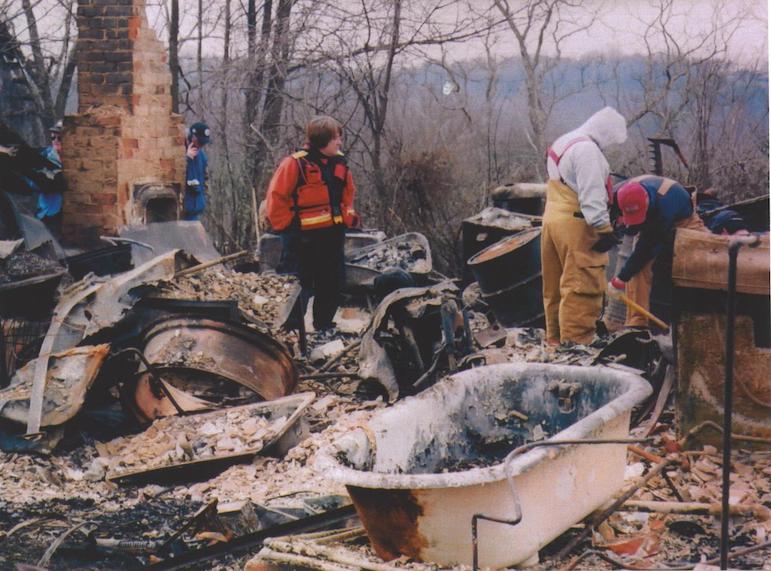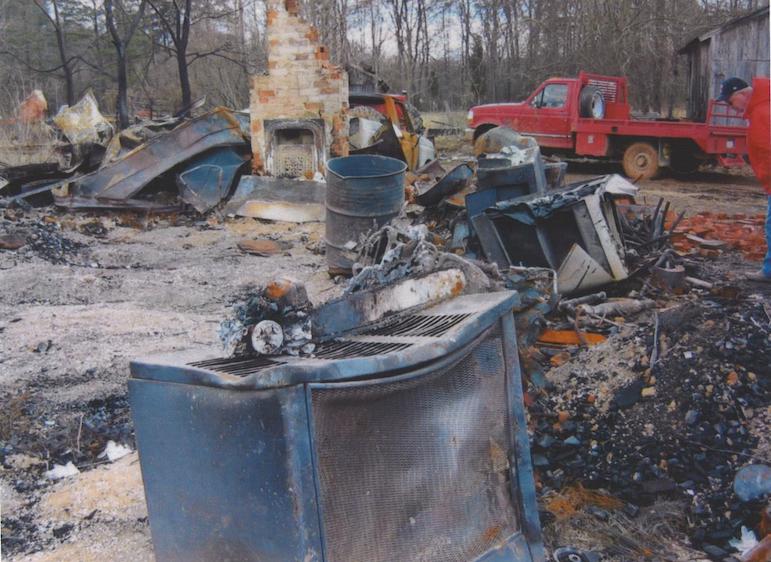This is the sixth in a series of articles reviewing and analyzing the facts and evidence related to the death of Judy Petty. Read the first article to learn about the facts and timeline surrounding Judy’s death. Read the second article for information on the initial investigation conducted by police and the fire department). The third article and fourth article provide a look at our team’s recent on-the-ground investigation. The fifth article covers aspects of Judy Petty’s autopsy report.
On Feb. 8, 2008, the charred remains of Judy Petty were found by her father in the cellar of an outbuilding on her family’s property in rural West Virginia. Judy had been missing for two days, and law enforcement officials and her family still don’t know how she ended up on her family’s property, 13 miles from where she lived in Parkersburg.
Consulting with Arson Expert Alan Haskins
Our team contacted Alan Haskins, Fire Science Program Director and an instructor at Black River Technical College in Pocahontas, Arkansas. Alan is a long-term firefighter and former paramedic; he also has an extensive career, spanning 30 years, in firefighting and arson investigation. We shared the photos of Judy’s crime scene, autopsy and original fire investigation reports with Alan to obtain his insights.
The Original Fire Investigation
In 2008, officials conducted two separate fire investigations. The Wood County Fire Investigative Team handled one investigation and state fire marshals conducted the other.
At that time, investigators were unable to identify any specific burn patterns due to the extreme damage to both the house and the outbuilding at the Petty farm. The reports mentioned that the fuel consumption of both fires was total, and no items susceptible to fire remained.

In addition, investigators observed that the ground vegetation between the outbuilding where Judy’s remains were found and the Petty house was intact. The distance between the two structures measured 32 feet, which led them to the conclusion that someone set multiple fires and that the original fire did not travel to other structures.
The teams were unable to determine the point of origin where the fire(s) began. They could also not determine whether the fires were purposeful or accidental.
The Location of Judy’s Remains Provides Important Clues
The outbuilding cellar in which Judy’s remains were found measured 12 feet in width, 15 feet in length and 6.5 feet in depth. The cellar is situated in a north to south direction.
Officials recovered Judy’s remains in the southeast corner of the cellar. According to reports, Judy was lying in an east to south orientation, with her head towards the east and feet towards the south.

The positioning of Judy’s body led Alan to conclude that someone placed her there. He believes her killer dragged Judy Petty to the location where her body was found. The killer likely would have grasped Judy’s body under her armpits and walked backward down the stairs in order to drag her to the cellar. Gravity assists when moving a body downstairs.
Alan found it highly unlikely that Judy was killed in the cellar, because the position of her body indicates she was dragged down the cellar stairs. She was found right at the bottom of the stairs, so the killer essentially took the easiest method necessary to hide the body and destroy it.
Alan considered the scenario that Judy’s killer could have placed her body on the ground (upper) level floor of the outbuilding and her body dropped into the cellar as the fire destroyed the outbuilding. However, he explained that the positioning of Judy Petty’s body does not support this theory.
Fire officials noted that they removed a great deal of debris from the top of Judy’s remains. There was no note of debris being found under her, which would be expected if her body dropped from the outbuilding’s upper floor.
Was an Accelerant Used to Start the Fire at the Petty Farm?
With any case of suspected arson, a key question is whether someone used an accelerant to start a fire. Alan believes the killer poured an accelerant on the southeast area of the cellar and possibly on Judy’s body. He noticed marks on the floor by Judy’s remains that indicate the use of an accelerant.
On the east and south walls of the cellar, Alan pointed out areas of spalling, a phenomenon that occurs in structure fires where the surrounding area is constructed with concrete. Concrete contains moisture so when a structure’s internal temperature exceeds 212 degrees Fahrenheit, the boiling point of water, it converts the moisture in the concrete to steam. As a result, the concrete in that structure cracks and can even break.

Alan feels the fire burned longer in the particular area of the outbuilding where Judy’s father found her body, based on the visual evidence. The point of origin of a fire is usually where the fire burns the longest. In this case, that’s the location where Judy’s body was situated.
Analyzing the Toxicology Report of Judy Petty
Alan explained that when someone dies in a structure fire, they usually die from inhaling toxic gases and smoke, not the fire itself. When this type of death occurs, a toxicology analysis of the victim’s blood or tissue can provide proof of inhalation of those gases and smoke. Red blood cells absorb carbon monoxide more quickly than oxygen, so the inhalation of carbon monoxide is readily apparent in a toxicology analysis.
In Judy’s case, part of her liver was recovered at the scene, and the medical examiner tested her liver tissue for the presence of drugs, alcohol, and carbon monoxide. Her carbon monoxide level was 3%, well below the toxic level. Victims who die as a result of a fire generally exhibit a carbon monoxide level of 60-70%. Alan concluded that Judy Petty did not die as a result of the fire and was dead prior to when the fire started.
Could Judy Petty Have Died in an Accidental Fire or from Suicide?
I asked Alan his opinion on whether Judy Petty died as a result of an accidental fire. He explained that if she’d started a fire that accidentally got out of control, her natural response would be to flee the scene and seek help from a neighbor and authorities. Her body was found by the cellar stairs, so she had an escape route no matter where the fire started in the outbuilding.
If Judy had started a fire and then suffered a medical emergency, she’d have inhaled the toxic gases and smoke, and the evidence of that would have been in her toxicology report. Therefore, according to Alan, an accident of this nature was very unlikely.
We also discussed the possibility of Judy starting a fire and then committing suicide. In my previous article, I mentioned that a weapon such as a gun or knife is often used in suicide, but no such weapon was recovered from the cellar.
There is a small possibility that Judy found a way to hang herself in the cellar and the fire destroyed the evidence of a hanging device. But her body position does not support that theory.
Additionally, unless Judy died almost instantaneously after setting the fire and hanging herself, the toxicologist would have found a much higher carbon monoxide level in her tissue. Consequently, her manner of death being a suicide is highly improbable.
How Long Did the Outbuilding Fire Burn?
In analyzing the fire set that destroyed Judy’s remains, I was curious as to how long the fire had to burn in order for Judy’s body to become as charred as it was. This information could help narrow down the timeframe during which the perpetrator set the fire.
When a body is legally cremated in a crematorium, the average temperature reaches 1,800-2,100 degrees Fahrenheit. A body takes one to two hours to be completely burned up in a crematorium, but the large bones still remain. These bones usually include the skull, feet, femur, vertebrae and the pelvis, which are the nearly the same set of bones retrieved in Judy’s case.
After studying the reports, Alan believes the fire reached 1,800-2,100 degrees Fahrenheit in that general location of the cellar. He explained that as the fire consumed the building, the contents from the upper floor of the building fell downward onto Judy’s body. The corrugated metal roof collapsed on top of all of it, further containing the heat and fire.
The entire fire was all contained in the pit of the cellar, which would cause it to burn longer. When the fire burnt itself out, it smoldered for many hours, which took an additional toll on Judy Petty’s body.
The Fire’s Point of Origin Was Likely in the Cellar
Alan strongly believes one fire was set in the cellar, either on or near Judy’s body, and then the fire spread to the main house. The general guideline fire departments provide homeowners who want to burn brush or build a firepit is to ensure they do so at least 50 feet from any structure.

Having a fire inside that 50-foot circumference can easily transfer enough radiant heat and flaming embers to a nearby structure and cause it to ignite. He does not believe multiple fires were set, but rather the one original fire spread to other areas.
Did Judy Petty Suffer from Blunt Force Trauma?
According to experts from the Smithsonian National Museum of Natural History, who analyzed Judy Petty’s remains, only 30%-40% of her skull was recovered after the fire. Alan explained that human bones will twist and fracture in a fire due to their internal moisture.

However, a fire will not cause a human skull to shatter into pieces too small to be recovered. Alan cannot rule out the possibility that Judy’s killer struck her in the head, and Judy had a fractured skull prior to the destruction of her body by the fire.

Final Conclusions
After analyzing the investigative reports and photos, Alan feels certain that Judy was killed prior to the fire. After the killer dragged her body down the cellar stairs and left it on the floor, the killer likely poured an accelerant on and around her body, then created a trail up the cellar stairs (so he/she wouldn’t be trapped in the cellar) and ignited the fire.
The most probable reason someone would go to the extent and risk of killing Judy Petty was to cover up a crime and destroy the evidence. If Judy’s body had been found intact, the specific cause of death could likely have been determined by the medical examiner. In turn, that would have likely provided clues about her killer.
Readers Can Assist in Finding Judy’s Killer
Readers can follow our progress on Judy Petty’s case and help our investigative team by joining our Facebook group dedicated to finding who killed Judy Petty. The group administrators regularly post updates on the case and discussion topics; also, readers are welcome to provide their input and ideas. In addition, you can listen to Season 1 of Safe Haven, an investigative podcast that covers our team’s real-time investigation into Judy Petty’s homicide.
If anyone has information about Judy Petty’s death, they can email our confidential tip address at tips@justice4judy.com or call the team’s tip line at 224-225-5208. Readers may also contact Doug Sturm, investigator for the Wood County Prosecuting Attorney’s office at 304-424-1776. All tipsters are guaranteed confidentiality and anonymity if they request it.

Comments are closed.